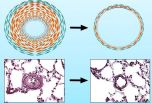(Press-News.org) CLEVELAND -- A study published in the journal International Scholarly Research Notices (ISRN) Stroke found that overall knowledge about stroke in Uganda was poor, although knowing what to do for a stroke – go to the hospital – was good.
Researchers from higher education institutions in Uganda collaborated with those from Case Western Reserve University and University Hospitals Case Medical Center to assess residents' knowledge of stroke symptoms and treatment options. To date, public perception and level of knowledge of stroke warning signs and risk factors in Uganda have not been well studied, and researchers believe this is the first study to do so. The researchers surveyed 1,600 residents, and found that three-quarters did not know any stroke risk factors and warning signs, or recognize the brain as the organ affected.
"Main findings are that stroke knowledge is poor with some groups being particularly uninformed, individuals do not personally believe stroke is something that can actually happen to them, and few individuals see primary health care workers as a resource for stroke prevention or care," the authors wrote.
"While this knowledge gap is daunting, it also illuminates multiple potential opportunities to improve general knowledge, especially among those at high risk for stroke and low level of education and help individuals in the future both reduce stroke risk and reduce complications should a stroke occur," they stated.
When asked what to do for a stroke, respondents said "going to hospital" most often (85.2 percent).
The researchers add that lack of knowledge about stroke among the public exists in developed countries such as the United States and Australia.
Stroke is one of the leading causes of mortality and disability worldwide, with developing countries accounting for 85 percent of global deaths from stroke. Lack of information and poor control of stroke risk-factors contribute to the rising incidence of stroke among Africans, according to the paper. Uganda is a nation in East Africa with a population of about 35 million people.
INFORMATION:
The authors are Jane Nakibuuka, Elly Katabira, and Jayne Byakika-Tusiime of Makerere University College of Health Sciences; Edward Ddumba, St. Raphael of St. Francis Nsambya Hospital, Nkozi University; and Martha Sajatovic and Anthony J. Furlan of University Hospitals Case Medical Center and Case Western Reserve University School of Medicine.
Case Western Reserve University and University Hospitals Case Medical Center have had a research relationship with Makerere University in Uganda for more than 25 years.
The ISRN Stroke study was published by National Institutes of Health's Pub Med on Sept. 6, 2014: http://www.ncbi.nlm.nih.gov/pmc/articles/PMC4156791/ The study was supported by a grant funded by the Office of the U.S. Global AIDS Coordinator (OGAC), National Institutes of Health (NIH) and Health Resources and Services Administration (HRSA).
Dr. Furlan said the study is worth noting in light of Oct. 29 being World Stroke Day, which was established by the World Stroke Organization in 2006 to help spread public awareness of the world's high stroke risk and stroke prevalence. "While stroke is the fourth leading cause of death and leading cause of disability in the U.S., many Americans do not think of stroke as a major health concern. And this project, which involved a physician exchange program between Uganda and UH and Case Western Reserve, lets us know that education about stroke is needed in other areas of the world as well."
For more information about World Stroke Day, see http://www.strokeassociation.org/STROKEORG/General/World-Stroke-Day-2012_UCM_444999_SubHomePage.jsp
About Case Western Reserve University School of Medicine
Founded in 1843, Case Western Reserve University School of Medicine is the largest medical research institution in Ohio and is among the nation's top medical schools for research funding from the National Institutes of Health. The School of Medicine is recognized throughout the international medical community for outstanding achievements in teaching. The School's innovative and pioneering Western Reserve2 curriculum interweaves four themes--research and scholarship, clinical mastery, leadership, and civic professionalism--to prepare students for the practice of evidence-based medicine in the rapidly changing health care environment of the 21st century. Nine Nobel Laureates have been affiliated with the School of Medicine.
Annually, the School of Medicine trains more than 800 MD and MD/PhD students and ranks in the top 25 among U.S. research-oriented medical schools as designated by U.S. News & World Report's "Guide to Graduate Education."
The School of Medicine's primary affiliate is University Hospitals Case Medical Center and is additionally affiliated with MetroHealth Medical Center, the Louis Stokes Cleveland Department of Veterans Affairs Medical Center, and the Cleveland Clinic, with which it established the Cleveland Clinic Lerner College of Medicine of Case Western Reserve University in 2002. http://casemed.case.edu
About University Hospitals
University Hospitals, the second largest employer in Northeast Ohio with 25,000 employees, serves the needs of patients through an integrated network of 15 hospitals, 28 outpatient health centers and primary care physician offices in 15 counties. At the core of our $3.5 billion health system is University Hospitals Case Medical Center, ranked among America's 50 best hospitals by U.S. News & World Report in all 12 methodology-ranked specialties. The primary affiliate of Case Western Reserve University School of Medicine, UH Case Medical Center is home to some of the most prestigious clinical and research centers of excellence in the nation, including cancer, pediatrics, women's health, orthopaedics, radiology, neuroscience, cardiology and cardiovascular surgery, digestive health, transplantation and genetics. Its main campus includes UH Rainbow Babies & Children's Hospital, ranked among the top children's hospitals in the nation; UH MacDonald Women's Hospital, Ohio's only hospital for women; and UH Seidman Cancer Center, part of the NCI-designated Case Comprehensive Cancer Center at Case Western Reserve University. For more information, go to http://www.uhhospitals.org
Study finds knowledge poor about stroke in Uganda
Survey done by Makerere University in Uganda, Case Western Reserve University School of Medicine and University Hospitals Case Medical Center
2014-10-27
ELSE PRESS RELEASES FROM THIS DATE:
NASA's Aqua satellite eyeing Tropical Cyclone Nilofar in Arabian Sea
2014-10-27
Tropical Cyclone 04A continues to intensify and had been renamed Tropical Cyclone Nilofar when NASA's Aqua satellite passed overhead on Oct. 27.
The MODIS instrument aboard Aqua captured a visible image of Nilofar that showed a ring of strong thunderstorms around the center of circulation and bands of thunderstorms wrapping into the low-level center from the east and west.
Nilofar attained hurricane strength on Oct. 27, when maximum sustained winds were near 75 knots (86 mph/139 kph) at 1500 UTC (11 a.m. EDT). Nilofar was centered near 15.2 north latitude and 62.2 east ...
When hearing aid users listen to music, less is more, says CU-Boulder study
2014-10-27
The type of sound processing that modern hearings aids provide to make speech more understandable for wearers may also make music enjoyment more difficult, according to a new study by the University of Colorado Boulder.
The findings, published in the journal Ear and Hearing, suggest that less sophisticated hearing aids might actually be more compatible with listening to music, especially recorded music that has itself been processed to change the way it sounds.
"Hearing aids have gotten very advanced at processing sounds to make speech more understandable," said Naomi ...
Delivering a one-two punch: New drug combination shows promise in treating breast cancer
2014-10-27
The uncontrolled growth of cancer cells arises from their ability to hijack the cell's normal growth program and checkpoints. Usually after therapy, a second cancer-signaling pathway will open after the primary one shuts down — creating an ingenious escape route for the cancer cell to survive. The answer, say Case Western Reserve researchers, is to anticipate and block that back-up track by prescribing two drugs from the start. The results of the project, led by Ruth Keri, PhD, Professor and Vice Chair Department of Pharmacology, and Associate Director for Basic Research ...
UH research focuses on suicide resilience and vulnerability
2014-10-27
Religious beliefs and practices may reduce thoughts of suicide among African-American adults in stressful life events induced by racial discrimination, according to a new research study conducted at the University of Houston (UH).
"African-Americans experience an inordinate amount of psychological strain through racial discrimination, leading to depression, hopelessness and other high risk factors for suicide, but demonstrate significantly lower rates of suicide relative to European-Americans," said Rheeda Walker, associate professor and director of the Culture, Risk ...
Synapses always on the starting blocks
2014-10-27
This news release is available in German.
While neurons rapidly propagate information in their interior via electrical signals, they communicate with each other at special contact points known as the synapses. Chemical messenger substances, the neurotransmitters, are stored in vesicles at the synapses. When a synapse becomes active, some of these vesicles fuse with the cell membrane and release their contents. To ensure that valuable time is not lost, synapses always have some readily releasable vesicles on standby. With the help of high-resolution, three-dimensional ...
Satellite movie shows Tropical Storm Ana headed to British Columbia, Canada
2014-10-27
VIDEO:
This animation of NOAA's GOES-West satellite imagery from Oct. 1 -27 shows the movement of Tropical Storm Ana as it heads toward British Columbia, Canada. TRT: 00:20.
Click here for more information.
An animation of imagery from NOAA's GOES-West satellite taken over the period of Oct.19 to 26 shows the movement, intensification, weakening and movement toward British Columbia, Canada. On Oct. 27, wind warnings were posted along some coastal sections of British Columbia.
During ...
Prostate cancer, kidney disease detected in urine samples on the spot
2014-10-27
When you flush the toilet, you may be discarding microscopic warning signs about your health.
But a cunningly simple new device can stop that vital information from "going to waste."
Brigham Young University chemist Adam Woolley and his students made a device that can detect markers of kidney disease and prostate cancer in a few minutes. All you have to do is drop a sample into a tiny tube and see how far it goes.
That's because the tube is lined with DNA sequences that will latch onto disease markers and nothing else. Urine from someone with a clean bill of health ...
Lack of transcription factor FoxO1 triggers pulmonary hypertension
2014-10-27
This news release is available in German.
Pulmonary hypertension is characterised by uncontrolled division of cells in the blood vessel walls. As a result, the vessel walls become increasingly thick.
Scientists at the Max Planck Institute for Heart and Lung Research in Bad Nauheim and Giessen University have discovered that transcription factor FoxO1 regulates the division of cells and plays a key role in the development of pulmonary hypertension. The researchers were able to cure pulmonary hypertension in rats by activating FoxO1. The study findings could ...
Study documents millions in unused medical supplies in US operating rooms each year
2014-10-27
A Johns Hopkins research team reports that major hospitals across the U.S. collectively throw away at least $15 million a year in unused operating room surgical supplies that could be salvaged and used to ease critical shortages, improve surgical care and boost public health in developing countries.
A report on the research, published online Oct. 16 in the World Journal of Surgery, highlights not only an opportunity for U.S. hospitals to help relieve the global burden of surgically treatable diseases, but also a means of reducing the cost and environmental impact of medical ...
Syracuse physicists closer to understanding balance of matter, antimatter in universe
2014-10-27
Physicists in Syracuse University's College of Arts and Sciences have made important discoveries regarding Bs meson particles—something that may explain why the Universe contains more matter than antimatter.
Distinguished Professor Sheldon Stone and his colleagues recently announced their findings at a workshop at CERN in Geneva, Switzerland. Titled "Implications of LHCb Measurements and Their Future Prospects," the workshop enabled him and other members of the Large Hadron Collider beauty (LHCb) Collaboration to share recent data results.
The LHCb Collaboration ...
LAST 30 PRESS RELEASES:
First Editorial of 2026: Resisting AI slop
Joint ground- and space-based observations reveal Saturn-mass rogue planet
Inheritable genetic variant offers protection against blood cancer risk and progression
Pigs settled Pacific islands alongside early human voyagers
A Coral reef’s daily pulse reshapes microbes in surrounding waters
EAST Tokamak experiments exceed plasma density limit, offering new approach to fusion ignition
Groundbreaking discovery reveals Africa’s oldest cremation pyre and complex ritual practices
First breathing ‘lung-on-chip’ developed using genetically identical cells
How people moved pigs across the Pacific
Interaction of climate change and human activity and its impact on plant diversity in Qinghai-Tibet plateau
From addressing uncertainty to national strategy: an interpretation of Professor Lim Siong Guan’s views
Clinical trials on AI language model use in digestive healthcare
Scientists improve robotic visual–inertial trajectory localization accuracy using cross-modal interaction and selection techniques
Correlation between cancer cachexia and immune-related adverse events in HCC
Human adipose tissue: a new source for functional organoids
Metro lines double as freight highways during off-peak hours, Beijing study shows
Biomedical functions and applications of nanomaterials in tumor diagnosis and treatment: perspectives from ophthalmic oncology
3D imaging unveils how passivation improves perovskite solar cell performance
Enriching framework Al sites in 8-membered rings of Cu-SSZ-39 zeolite to enhance low-temperature ammonia selective catalytic reduction performance
AI-powered RNA drug development: a new frontier in therapeutics
Decoupling the HOR enhancement on PtRu: Dynamically matching interfacial water to reaction coordinates
Sulfur isn’t poisonous when it synergistically acts with phosphine in olefins hydroformylation
URI researchers uncover molecular mechanisms behind speciation in corals
Chitin based carbon aerogel offers a cleaner way to store thermal energy
Tracing hidden sources of nitrate pollution in rapidly changing rural urban landscapes
Viruses on plastic pollution may quietly accelerate the spread of antibiotic resistance
Three UH Rainbow Babies & Children’s faculty elected to prestigious American Pediatric Society
Tunnel resilience models unveiled to aid post-earthquake recovery
Satellite communication systems: the future of 5G/6G connectivity
Space computing power networks: a new frontier for satellite technologies
[Press-News.org] Study finds knowledge poor about stroke in UgandaSurvey done by Makerere University in Uganda, Case Western Reserve University School of Medicine and University Hospitals Case Medical Center







